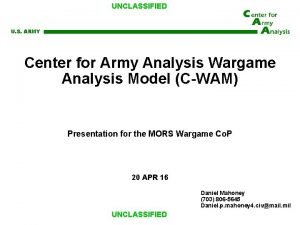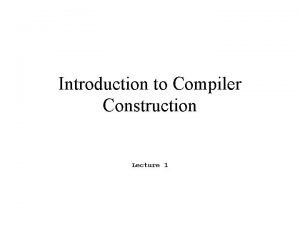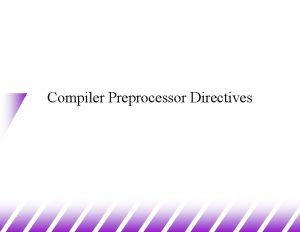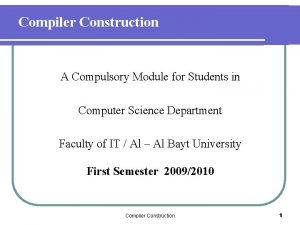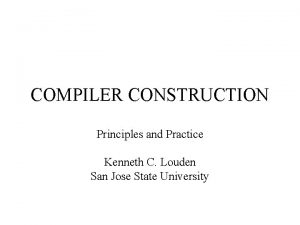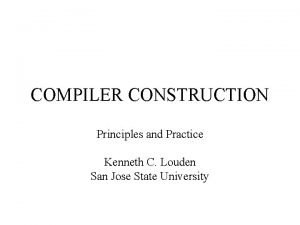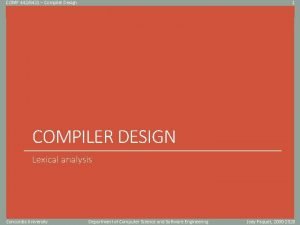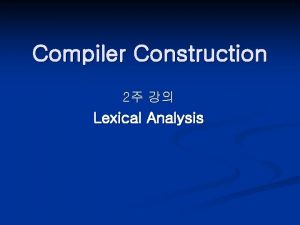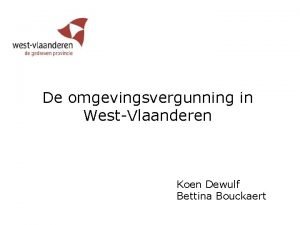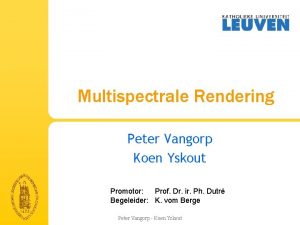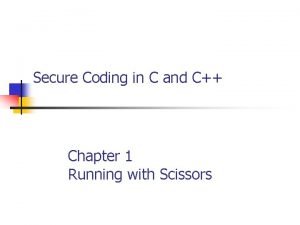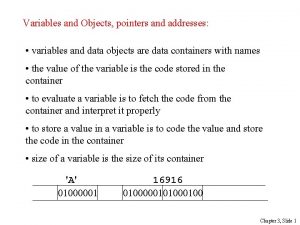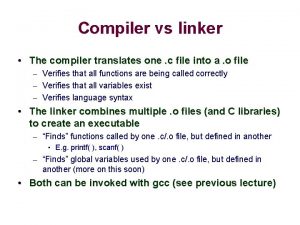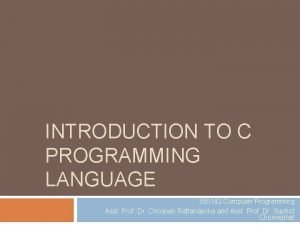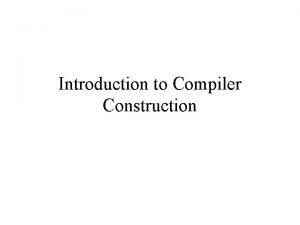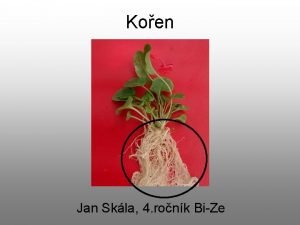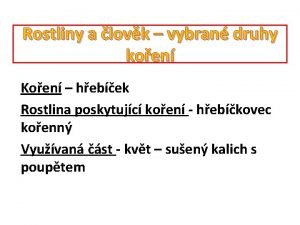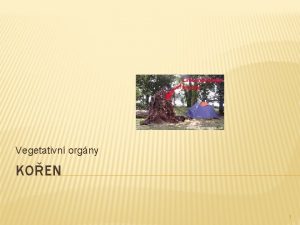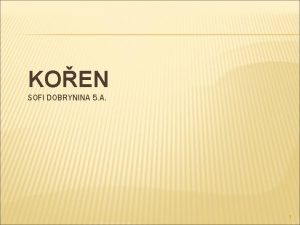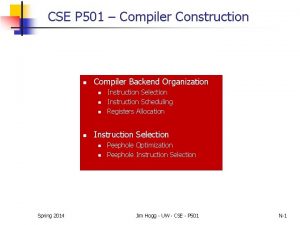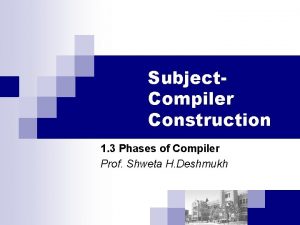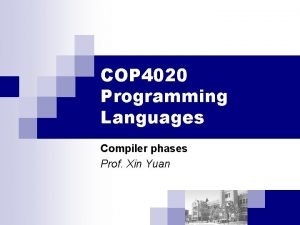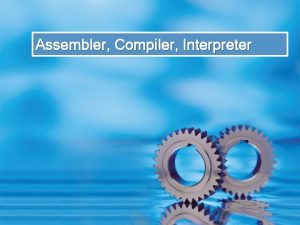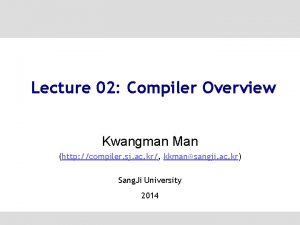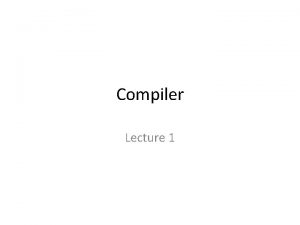Compiler construction in 4020 lecture 9 Koen Langendoen

































![Code optimization • preprocessing • • constant folding strength reduction a[1] *(a+4*1) *(a+4) 4*i Code optimization • preprocessing • • constant folding strength reduction a[1] *(a+4*1) *(a+4) 4*i](https://slidetodoc.com/presentation_image/0df7aba33cd55ac9d244503752d56afe/image-34.jpg)


- Slides: 36

Compiler construction in 4020 – lecture 9 Koen Langendoen Delft University of Technology The Netherlands

Summary of lecture 8 • interpretation • recursive • iterative program text front-end annotated AST • simple code generation • • code per AST node stack and register machines weighted register allocation register spilling intermediate code generation interpreter back-end assembly

Quiz 4. 7 Can the weight of a tree can also be used to reduce the maximum stack height when generating code for a stack machine? If not, why? If yes, how?

Overview annotated AST code generator • code generation for basic blocks • [instruction selection: BURS] • register allocation: graph coloring • instruction ordering: ladder sequences library assembler object file linker executable

Code generation for basic blocks • improve quality of code emitted by simple code generation • consider multiple AST nodes at a time basic block: a part of the control graph that contains no splits (jumps) or combines (labels) • generate code for maximal basic blocks that cannot be extended by including adjacent AST nodes

Code generation for basic blocks • a basic block consists of expressions and assignments { int n; n x n y = = a+1; (b+c) * n; n+1; (b+c) * n; } • fixed sequence (; ) limits code generation • an AST is too restrictive

{ int n; Example AST n x n y = = a+1; (b+c) * n; n+1; (b+c) * n; } =: + a n ; ; ; =: =: * 1 + b x n c + n n * 1 + b y n c

Dependency graph • convert AST to a directed acyclic graph (dag) capturing essential data dependencies • data flow inside expressions: operands must be evaluated before operator is applied • data flow from a value assigned to variable V to the use of V: the usage of V is not affected by other assignments

AST to dependency graph AST • replace arcs by downwards arrows • • (upwards for destination under assignment) insert data dependencies from use of V to preceding assignment to V insert data dependencies between consecutive assignments to V add roots to the graph (output variables) remove ; -nodes and connecting arrows dependency graph

Example dependency graph { int n; n x n y } = = a+1; (b+c) * n; n+1; (b+c) * n; x y * * + b + c a + 1

Common subexpression elimination • common subexpressions occur multiple times and evaluate to the same value { int n; n x n y } = = a+1; (b+c) * n; n+1; (b+c) * n; x y * * + b + c a + 1

Exercise (7 min. ) • given the code fragment x : = a*a + 2*a*b + b*b; y : = a*a – 2*a*b + b*b; draw the dependency graph before and after common subexpression elimination.

Answers

Answers dependency graph before CSE x y + + + * a 2 - * b b * a b * * a 2 b b * a b

Answers dependency graph after CSE + * * 2 y + + - * * a x b * * a 2 b b * a b

Answers dependency graph after CSE + * * 2 y + + * * a x b -

Break

From dependency graph to code • target: register machine (lecture 8) with additional operations on memory • reg op: = reg Add_Reg R 2, R 1 • reg op: = mem Add_Mem x, R 1 • rewrite nodes with machine instruction templates, and linearize the result • instruction ordering: ladder sequences • register allocation: graph coloring

Linearization of the data dependency graph • example: (a+b)*c – d Load_Mem a, R 1 Add_Mem b, R 1 Mul_Mem, c, R 1 Sub_Mem d, R 1 • definition of a ladder sequence • each root node is a ladder sequence • a ladder sequence S ending in operator node N can be extended with the left operand of N • if operator N is communitative then S may also extended with the right operand of N

Linearization of the data dependency graph • code generation for a ladder sequence x y * * + b + c a + 1 1

Linearization of the data dependency graph • code generation for a ladder sequence + b x x R 1, x Store_Mem * Mul_Reg * R T, R 1 RT c Add_Mem + c, R 1 RT Load_Mem b, b R 1 c • instructions from bottom to top, one register

Linearization of the data dependency graph • late evaluation – don’t occupy registers • select ladder sequence S without additional incoming dependencies • introduce temporary registers for non-leaf operands, which become additional roots • generate code for S, using R 1 as the ladder register • remove S from the graph • note: code blocks produced in reverse order

Example code generation x 1) ladder: y, *, + Load_Const 1, R 1 Add_Reg R 3, R 1 Mul_Reg, R 2, R 1 Store_Mem R 1, y 2) ladder: x, * Load_Reg R 2, R 1 Mul_Reg R 3, R 1 Store_Mem R 1, x R 2 y R 3 * + b * + + c a 1 3) ladder: R 2, + Load_Mem b, R 1 Add_Mem c, R 1 Load_Reg R 1, R 2 1 4) ladder: R 3, + Load_Const 1, R 1 Add_Mem c, R 1 Load_Reg R 1, R 3

Exercise (7 min. ) • generate code for the following dependency graph + * * 2 y + + * * a x b -

Answers

x Answers 1) ladder: x, +, + Load_Reg R 2, R 1 Add_Reg R 3, R 1 Add_Reg, R 4, R 1 Store_Mem R 1, x 2) ladder: y, +, Load_Reg R 2, R 1 Sub_Reg R 3, R 1 Add_Reg, R 4, R 1 Store_Mem R 1, y + R 2 R 3 + * * a y R 4 + * - b * 2 3) ladder: R 3, *, * Load_Const 2, R 1 Mul_Reg Ra, R 1 Mul_Reg, Rb, R 1 Load_Reg R 1, R 3 4) ladder: R 2, * Load_Reg Ra, R 1 Mul_Reg Ra, R 1 Load_Reg R 1, R 2 5) ladder: R 4, * Load_Reg Rb, R 1 Mul_Reg Rb, R 1 Load_Reg R 1, R 4

Register allocation by graph coloring • procedure-wide register allocation • only live variables require register storage dataflow analysis: a variable is live at node N if the value it holds is used on some path further down the control-flow graph; otherwise it is dead • two variables(values) interfere when their live ranges overlap

Live analysis a b c d : = : = read(); a read(); b read(); c d a + b*c; d < 10 e e : = c+8; print(c); f : = 10; e e : = f + d; print(f); print(e); f a : = read(); b : = read(); c : = read(); d : = a + b*c; if (d < 10 ) then e : = c+8; print(c); else f : = 10; e : = f + d; print(f); fi print(e);

Register interference graph a b c d : = : = read(); a read(); b read(); c d a + b*c; d < 10 e e : = c+8; print(c); f : = 10; e e : = f + d; print(f); print(e); f a b c d e f

Graph coloring • NP complete problem a b • heuristic: color easy nodes last c d • • find node N with lowest degree e remove N from the graph color the simplified graph set color of N to the first color that is not used by any of N’s neighbors f

Exercise (7 min. ) { int tmp_2 ab = 2*a*b; int tmp_aa = a*a; int tmp_bb = b*b; x : = tmp_aa + tmp_2 ab + tmp_bb; y : = tmp_aa - tmp_2 ab + tmp_bb; } given that a and b are live on entry and dead on exit, and that x and y are live on exit: (a) construct the register interference graph (b) color the graph; how many register are needed?

Answers

Answers a tmp_2 ab x b tmp_aa tmp_bb 4 registers are needed y
![Code optimization preprocessing constant folding strength reduction a1 a41 a4 4i Code optimization • preprocessing • • constant folding strength reduction a[1] *(a+4*1) *(a+4) 4*i](https://slidetodoc.com/presentation_image/0df7aba33cd55ac9d244503752d56afe/image-34.jpg)
Code optimization • preprocessing • • constant folding strength reduction a[1] *(a+4*1) *(a+4) 4*i i<<2 in-lining. . . • postprocessing • peephole optimization: replace inefficient patterns Load_Reg R 2, R 1 Load_Reg R 1, R 2 Load_Reg R 2, R 1

Summary annotated AST code generator • dependency graphs assembly • code generation for basic blocks • instruction selection: BURS • register allocation: graph coloring • instruction ordering: ladder sequences library assembler object file linker executable

Homework • study sections: • 4. 2. 6 BURS code generation • assignment 2 (next week, chap 6): • make Asterix OO • deadline June 4 08: 59 • print handout for next week [blackboard]
 Cross compiler in compiler design
Cross compiler in compiler design Yacc tutorial
Yacc tutorial Oplan 4020
Oplan 4020 Slip gaji dg44
Slip gaji dg44 As/nzs 4020
As/nzs 4020 Compiler lecture
Compiler lecture Preprocessor in compiler construction
Preprocessor in compiler construction Phases of compiler construction
Phases of compiler construction Advantages and disadvantages of interpreter and compiler
Advantages and disadvantages of interpreter and compiler Front end of compiler
Front end of compiler Compiler
Compiler Compiler construction principles and practice
Compiler construction principles and practice Front end phases of compiler
Front end phases of compiler Thompson construction in compiler design
Thompson construction in compiler design Lexical analysis in compiler construction
Lexical analysis in compiler construction Type checking and type conversion in compiler design
Type checking and type conversion in compiler design 01:640:244 lecture notes - lecture 15: plat, idah, farad
01:640:244 lecture notes - lecture 15: plat, idah, farad 4 ps of project management
4 ps of project management Dr koen peeters
Dr koen peeters Koen vancraeynest
Koen vancraeynest Stap hdgi
Stap hdgi Koen dewulf west-vlaanderen
Koen dewulf west-vlaanderen Dr koen van besien
Dr koen van besien Dokter koen thomeer
Dokter koen thomeer Koen van der schaft
Koen van der schaft Kristof titeca
Kristof titeca Diffractie
Diffractie Koen van deun
Koen van deun Koen de boeck
Koen de boeck Kelembagaan sosial
Kelembagaan sosial Internationale competenties
Internationale competenties C++ compiler
C++ compiler Language translator
Language translator C c++ compiler
C c++ compiler Ssrange in cobol example
Ssrange in cobol example Compiler vs linker
Compiler vs linker 350142
350142


